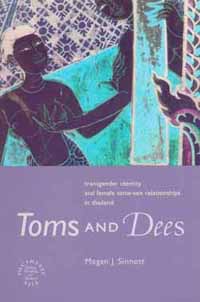-
Megan Sinnott's book, Toms and Dees: Transgender Identity and Female Same-Sex Relationships in Thailand (2004) makes an innovative, invaluable and well overdue contribution to the limited English language literature on gender identities and female same-sex relationships in Southeast Asia. Sinnott's work is the first book to address at length these issues prevalent in Thailand. The terms tom and dee are etymologically derived from the English language words, 'tomboy' and 'lady' (or lay-dee), and serve to describe female same-sex relationships. However, it is important not to equate such Thai identities with that of the Western concept of 'lesbian,' as to do so fails in an understanding of the subtle cultural nuances that separate Thai culture from the West.
-
Thais not uncommonly use a derivative of an English language word when there is no Thai equivalent. Another such derivation is the word faen, when referring to a boyfriend or girlfriend, in contrast to a more 'permanent' relationship, such as marriage. As Sinnott notes, such westernised English language-derived terms are indicative of social change and 'tied symbolically to the West' (p. 27). However, as Sinnott argues, to position 'tom, dee, and gay identities as products of western discourse, reifies the dichotomous categories of western/local and modern/traditional and fails to capture the complexity of cultural change and gender' (p. 27).
-
The book is organised into an Introduction, followed by seven chapters. Chapter One, 'Global Sex', sets the scene by providing a background to the way that sexual identity has been globalised in Southeast and East Asia, and describes how lesbian organisations and networks have developed in the region. Sinnott argues that transnationalism and socioeconomic forces have influenced such developments in Thailand. However, Sinnott questions whether such identities as tom and dee are the products of globalisation and Western influences; Westernisation, for Sinnott, denotes a 'double-edged sword,' indicating at once 'progress' and 'modernity' along with the symbolic loss of Thai traditional values and identities (p. 24).
-
In Chapter Two, Sinnott sets about examining the topic of socio-cultural change and notes that while 'tom and dee identities are new cultural categories' in that they emerged in the 1980s, at the same time they 'share similarities with local traditions in which masculinity and female same-sex sexuality have been recognised and practiced' (p. 47). In this section Sinnott examines the Thai cultural notion of len pheuan [playing [with] friends] and King Borommatrailokanat's law issued in the Ayuthaya period (1350-1767) that prohibited his concubines from having sexual relationships with each other. Female same-sex sexual activity was punishable by fifty lashes, followed by tattooing of the neck and parading the woman around the palace. In 1856 King Rama IV of Siam warned his female children not to involve themselves with len pheuan. It is noteworthy that len pheuan refers to sexual activity between two women, as distinct from sexual-gender identity. Sinnott quotes one tom as saying she was a tom before the advent of the term tom to describe the gender identity of a masculine identifying woman.
-
However, while Sinnott draws attention to historical evidence that female same-sex relationships were an established component of Siamese tradition, she is not arguing that 'Thai discourses of sexuality and gender have remained unchanged' (p. 60). Rather, that since the early part of the twentieth century, Siam/Thailand has 'appropriated' Western discourses in this regard. Such appropriation has developed into distinct social identities for toms [masculine identifying women] and their same-sex partners, dees (p. 63).
-
Chapters Three, Four and Five of Sinnott's book address gender ambivalence in tom-dee identities, Thai norms of gender and sexuality and gender dynamics between toms and dees respectively. In Chapter Three, Sinnott notes that qualities such as good provider, protector and leader are ideals which define a tom as distinct from a dee. A tom must be 'nak-leng' or 'chai-chatrii', terms which indicate that the tom has 'manly' qualities such as being 'brave', 'daring', 'risk-taking' and 'fair' (p. 88). 'Nak-leng' also implies other 'manly' traits, such as being 'tough' or a 'playboy who has numerous affairs with women' (p. 88), and Sinnott states that toms 'strive to display these qualities' (p. 88).
-
Some dees value 'caretaking' qualities in a tom. For dees, the sexual role of the tom is not so important as the 'social role' that they fulfilled in caring for them. Other dees value the 'blend of masculine and feminine characteristics' of the tom (p. 91). However, toms are also valued for doing housework (which men do not do) and dees are valued for being attentive to their tom partners. 'The performance of tom masculinity', then, is according to Sinnott, 'woven into hegemonic notions of masculinity but is not isomorphic with it' (p. 92). In Chapter Four Sinnott explains the ways in which female same-sex relationships serve to accommodate Thai norms of gender and sexuality, without the 'dangers' and 'risk' involved in female heterosexual sexual activity. The tom-dee relationship is viewed as 'asexual' and thus for Thai women, comes free of the moral dangers associated with heterosexual relationships and women's promiscuity (p. 111).
-
Sinnott's book is exceptional in that it is the only one of its kind to be published in the English language. The great strength of the book lies in Sinnott's rich ethnographic data that portray the life stories of tom and dee identifying women. Sinnott's protracted fieldwork in Thailand (she lived and worked in the country for ten years) and her enviable Thai language skills, that include not only speaking, but also reading and writing the language, make her book uniquely valuable to scholars of anthropology, researchers of sexualities in Southeast Asia and academics alike. The importance of Megan Sinnott's book is immeasurable in many ways. It is indeed an accomplished piece of work.

|

